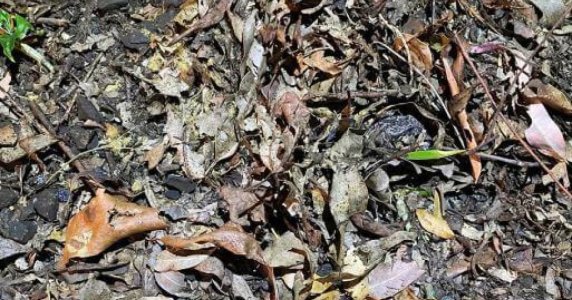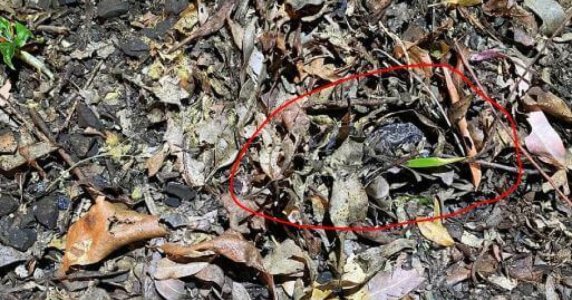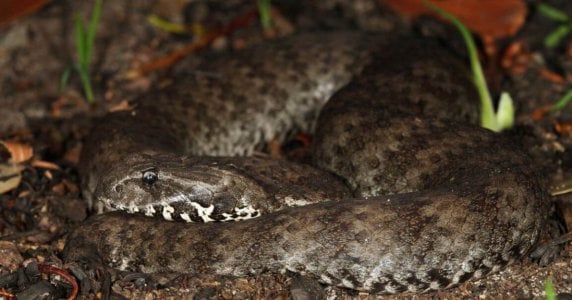This photo is full of danger – can you spot the reason why?
- Replies 5
Aussie bushland is rich with natural beauty, from eucalyptus forests and fern valleys to lush mountains and pristine beaches. But, as mesmerising as it is, our wilderness can also be filled with hidden dangers.
One of the most deadly and venomous creatures that can be found roaming around in the Australian wilderness is said to have mastered the craft of camouflage.
Bushwalkers have been urged to be wary whenever they’re out and about. This comes after a Queensland man recently highlighted a dangerous creature hiding in plain sight in a photo he posted to a popular Facebook group.
‘Does anyone fancy playing I Spy? This might be a bit of an easy one for some,’ he wrote in his post.
‘Found up Mt Glorious, Brisbane, last night,’ he added.
While some social media users managed to find the hidden danger, many were stumped by the photo.
‘I can’t see a single thing. Maybe I should avoid hiking,’ one commented.
‘I think I need to go to Specsavers because I cannot see it,’ another replied.
While a third said they’d probably be dead before they could even find the danger. ‘Couldn’t see it at all,’ they shared.
The image shows leaf litter, dirt, and rocks – an area that most people would dismiss as a ‘safe’ space to step on.
However, a closer look at the centre-right of the image reveals a snake’s head poking out above a green leaf, with its dark-scaled body blending in perfectly with the surrounding scattered debris.
The creature hiding in the photo is a Common Death Adder, or acanthopis antarcticus – one of the most venomous snakes in the world.
Although they are generally non-aggressive reptiles, they can be quite difficult to spot in the wild.
The Common Death Adder is characterised by its triangular-shaped head, short, stout body, and thin tail.
Bryan Fry, an Associate Professor from the School of Biological Sciences at the University of Queensland, said that the Death Adder is an ambush animal. ‘Death Adders are the classic sit-and-wait type of ambush feeder,’ he told reporters.
He added that, unlike most snakes, the Death Adder does not actively search for its prey. ‘They park themselves by an area that smells like potential prey, use it as a movement corridor, and then wait motionless for weeks at a time, relying on their amazing camouflage. Basically, they are the venomous equivalent of a land mine,’ Professor Fry explained.
These reptiles feed on frogs, lizards, and birds. It ‘hunts’ by covering itself with leaves, making it inconspicuous, and lies coiled, waiting for unsuspecting prey. It twitches its yellowish, grub-like tail to lure food, and once an animal gets close to investigate the movement, the death adder strikes instantly. It deposits venom into the bloodstream and waits for the prey to die before eating it.
Professor Fry also noted that the Death Adder’s evolutionary reliance on camouflage makes it vulnerable to the destruction of its habitat.
‘This perfect adaptation is also what is making them decline in numbers quite quickly in areas that are no longer pristine habitats. Any modification of the environment risks breaking the perfect match their colours and patterns have with the background. Making them stand out more, which decreases their hunting effectiveness,’ he explained.
Professor Fry declared that this change makes them more vulnerable to birds of prey and goannas.
‘This underscores the importance of national parks, as they preserve habitat that is essential for some species’ continued survival,’ he claimed.
The Common Death Adder is no longer found in Victoria, and it is scarce in the Northern Territory and Western Australia. It was once found all around the coast of the country’s mainland but now is only common on the east coast.
The species is not considered endangered yet. However, habitat loss and invasive cane toads threaten their numbers.
Death Adders have large fangs and toxic venom that can cause human death six hours after the initial bite. Meanwhile, small mammals such as pet dogs and cats experience worse reactions and live only 20 minutes after being bitten.
Symptoms of a bite include:
 Have you ever encountered this snake before, folks? If so, what did you do? Share your thoughts with us in the comments below!
Have you ever encountered this snake before, folks? If so, what did you do? Share your thoughts with us in the comments below!
One of the most deadly and venomous creatures that can be found roaming around in the Australian wilderness is said to have mastered the craft of camouflage.
Bushwalkers have been urged to be wary whenever they’re out and about. This comes after a Queensland man recently highlighted a dangerous creature hiding in plain sight in a photo he posted to a popular Facebook group.
‘Does anyone fancy playing I Spy? This might be a bit of an easy one for some,’ he wrote in his post.
‘Found up Mt Glorious, Brisbane, last night,’ he added.
While some social media users managed to find the hidden danger, many were stumped by the photo.
‘I can’t see a single thing. Maybe I should avoid hiking,’ one commented.
‘I think I need to go to Specsavers because I cannot see it,’ another replied.
While a third said they’d probably be dead before they could even find the danger. ‘Couldn’t see it at all,’ they shared.
The image shows leaf litter, dirt, and rocks – an area that most people would dismiss as a ‘safe’ space to step on.
However, a closer look at the centre-right of the image reveals a snake’s head poking out above a green leaf, with its dark-scaled body blending in perfectly with the surrounding scattered debris.
The creature hiding in the photo is a Common Death Adder, or acanthopis antarcticus – one of the most venomous snakes in the world.
Although they are generally non-aggressive reptiles, they can be quite difficult to spot in the wild.
The Common Death Adder is characterised by its triangular-shaped head, short, stout body, and thin tail.
Bryan Fry, an Associate Professor from the School of Biological Sciences at the University of Queensland, said that the Death Adder is an ambush animal. ‘Death Adders are the classic sit-and-wait type of ambush feeder,’ he told reporters.
He added that, unlike most snakes, the Death Adder does not actively search for its prey. ‘They park themselves by an area that smells like potential prey, use it as a movement corridor, and then wait motionless for weeks at a time, relying on their amazing camouflage. Basically, they are the venomous equivalent of a land mine,’ Professor Fry explained.
These reptiles feed on frogs, lizards, and birds. It ‘hunts’ by covering itself with leaves, making it inconspicuous, and lies coiled, waiting for unsuspecting prey. It twitches its yellowish, grub-like tail to lure food, and once an animal gets close to investigate the movement, the death adder strikes instantly. It deposits venom into the bloodstream and waits for the prey to die before eating it.
Professor Fry also noted that the Death Adder’s evolutionary reliance on camouflage makes it vulnerable to the destruction of its habitat.
‘This perfect adaptation is also what is making them decline in numbers quite quickly in areas that are no longer pristine habitats. Any modification of the environment risks breaking the perfect match their colours and patterns have with the background. Making them stand out more, which decreases their hunting effectiveness,’ he explained.
Professor Fry declared that this change makes them more vulnerable to birds of prey and goannas.
‘This underscores the importance of national parks, as they preserve habitat that is essential for some species’ continued survival,’ he claimed.
The Common Death Adder is no longer found in Victoria, and it is scarce in the Northern Territory and Western Australia. It was once found all around the coast of the country’s mainland but now is only common on the east coast.
The species is not considered endangered yet. However, habitat loss and invasive cane toads threaten their numbers.
Death Adders have large fangs and toxic venom that can cause human death six hours after the initial bite. Meanwhile, small mammals such as pet dogs and cats experience worse reactions and live only 20 minutes after being bitten.
Symptoms of a bite include:
- Muscle paralysis
- Abdominal pain
- Drowsiness
- Enlargement of regional lymph nodes
- Headaches
Key Takeaways
- Bushwalkers have been warned to be on the lookout for the master of camouflage, the Common Death Adder.
- The snake blends in all but perfectly with its surroundings and can be difficult to spot.
- Common Death Adders have adapted so well to their surroundings that their habitat is becoming increasingly vulnerable to human-driven destruction.
- This species of snake is now only found on the east coast of Australia and is threatened by both habitat loss and invasive cane toads.










